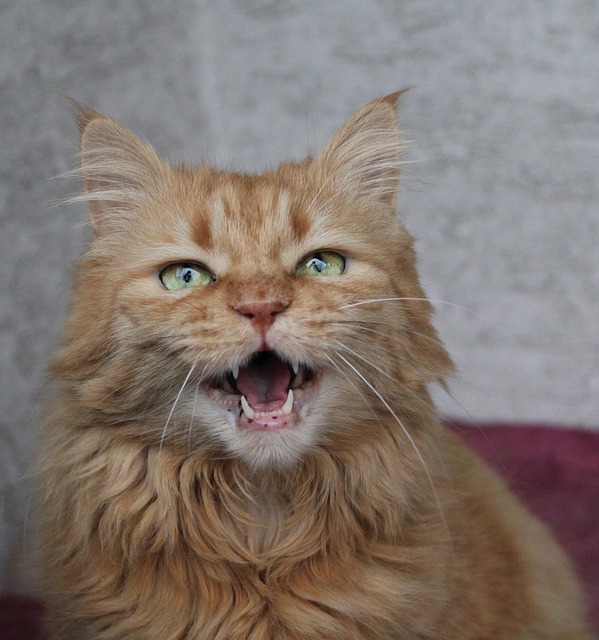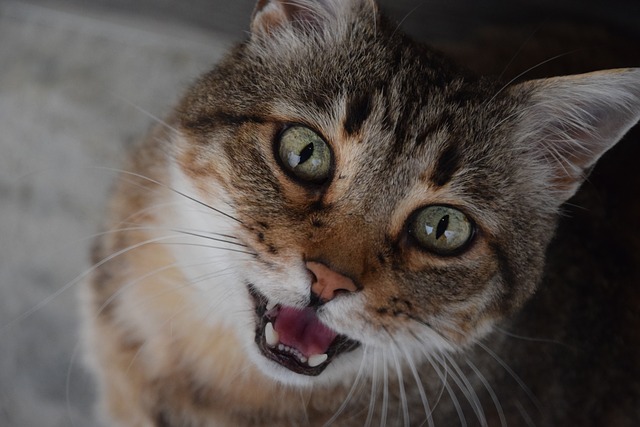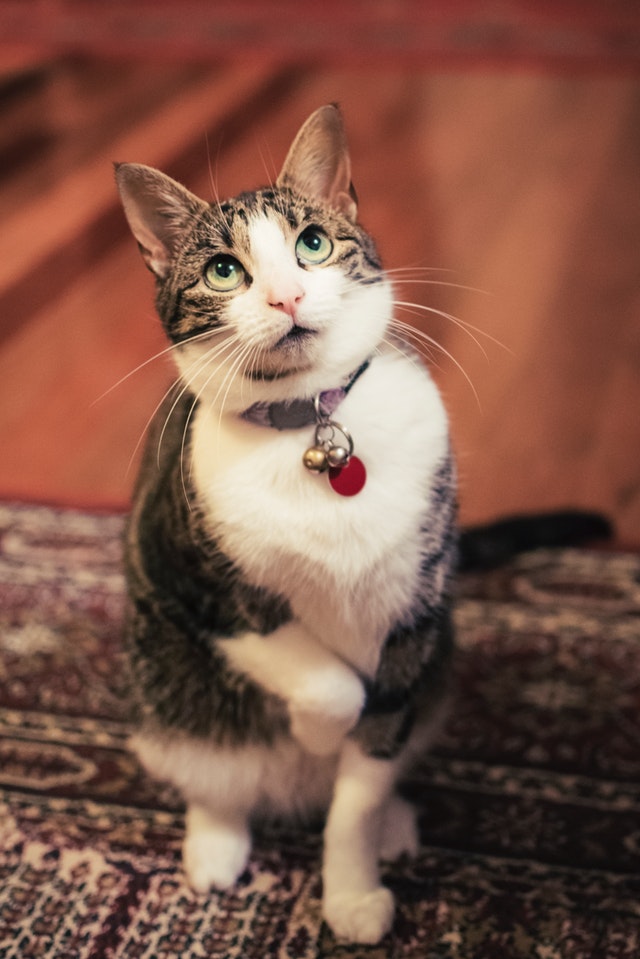When I got my little Suzy, I was asking myself how to communicate with your cat? I was so confused! Becoming a cat owner is a significant step in my life, but communicating with her was challenging!
Your cat may not speak your language! BUT, they are trying to communicate with you. Some scientists have discovered that our fluffy cats evolved enough to develop a communication system to communicate with us. Unfortunately, most of us miss that, or we don’t pay attention to them.
Having excellent communication and start talking to your cat is a unique opportunity to help you cultivate a more nuanced relationship with your cat. Also, it is a great way to improve your health physically and psychologically.
Before we start talking about how to communicate with a cat, We need to understand what is the meaning of animal communications.

Table of Contents
Animal Communication
According to Wikipedia, “Animal communication is the transfer of information from one or a group of animals (sender or senders) to one or more other animals (receiver or receivers) that affects the current or future behavior of the receivers.”
If we reread this definition, we will notice that they wrote “transfer of information,” not “speaking.” That means speaking is just one way to communicate, and it is a special thing for Humans!
However, speaking is just a part of a more significant definition. If we start digging deep into the meaning of animal communication, we will find that there are different modes of interaction between animals. Visual, Auditory, Olfactory, Electric, Touch, Seismic, Thermal.
Now, some people may ask. Why are we talking about all this?
Well, your cat is an animal, and it considers you like an animal. Your cat can’t speak to you, but it will communicate with you using different methods. Understanding animal communication will make it easier for you to communicate with your cat.
Communicating With Your Cat
Some cat owners don’t talk to their cats. That’s wrong!
As a starter, you can talk to your cat just like humans. In fact, the more you talk to your cat, the more your cat will learn and communicate with you better.
Give it time; you both will understand each other. Then, you will learn different things about your cat and how your cat feels. For Example, You will start learning when it is time to get up ( at least in your cat’s opinion). You will even learn when your cat is feeling affectionate or when your cat is feeling threatened.
You need to understand that cats are different from dogs in so many things. Dogs are easy to be understood. Cats are not that easy. There are many things you need to pay attention to when you want to communicate with your lovely cat.

How To Communicate With Your Cat – Methods
Method One: Reading Your Cat Body Language
1- Cats Tail: Just like dogs, cats use their tails to communicate with you. They are mostly using their tails to inform you about their stats.
They use positioning and movement of their tails as signals to you to help you understand the needs and wants of your cat.
- Happiness can be indicated with a straight-up tail and curl at the end.
- If your cat is excited or anxious, the tail will be twitching.
- Playful, excited or threatened cat, the fur on the tail will be bushy or sticking up.
- Your cat is happy and excited to see you, the tail will be vibrating.
- Your cat is aggressive and ready to fight, the Tail fur sticks straight up while the tail curls in the end in the shape of N.
- Your cat is aggressive or frightened, the tail fur straight up, but it is held low.
- Your cat is frightened; the tail is held low and tucked under the rear.
2- Cat eyes: Gazing into your love eye can help you bond with them and read their feelings. The same thing goes for your cat. Look at your cat’s eyes, but be careful not to stare without blinking. This is considered a sign of aggression, which will make your cat feeling uneasy and uncomfortable.
- Notice your cat pupils while staring at them. If your cat’s pupils are dilated, that is either a good sign or a bad one. Dilated pupils can mean either feeling very playful and excited OR fearful and aggressive.
- When you start noticing your cat staring at your eyes, that means your cat trusts you and feeling comfortable around you.
- Your cat blinking eyes slowly may show affectionate.
3- Cat’s body language as a whole: Your cat is better than you in body language, that been said, pay more attention to your cat body language more than just its eyes and tail. Our cats are fluent in this language. They adapted and evolved to be able to use it much better than humans.
- Your cat feels fear, anxiety, or playfulness; it lays its ears back and sniffing something cautiously.
- Your cat acknowledged you; your cat will lift its nose and tilt the head slightly back.
- Your cat is apprehensive or worried; it will flick its tongue out slightly and licks lower lip.
4- Cats behavior around you: Your cat behavior is one of the most critical signs of communication with you. Most of the time, your cat’s cuddling, you don’t mean just cuddling. It is trying to communicate and tell you something.
- The wet nose kiss! Some people find it disgusting. But, this is a significant sign showing affectionate. Your cat feels comfortable around you.
- Playful head-butting is a common sign for friendliness and affectionate.
- Cats are sniffing your face to confirm their identity based on the familiarity of the smell.
- Your cat is rubbing its head, tail, and flank against you? That’s a cat’s greeting. They are greeting you in that way.
- When your cat starts rubbing against you, that means it is marking you as its property. So your cat owns you now!

Method Two: Communicating and talking with Your Cat
1- As I said before. Talking to your cat is a great way to let your cat learn how to communicate with you. Cats, just like kids. You need to keep talking to them, and eventually, they will start to understand you, and you understand them. Cats are fast learners, so keep that in your mind and keep talking to them.
- Repetition is a great way to help your cat learn to anticipate consistent activities. For example, When you keep telling your cat to sleep and going to sleep afterward, that will let your cat connect sleeping with the action of sleeping, and it will learn that after repeating it several times.
- Use a slightly raised tone of voice. In cats’ world, this indicates friendliness. A low tone of voice suggests aggression.
2- Non-verbal Communication: It is in cats’ instinct to understand nonverbal communication. Cats can be trained to understand words, but it will be easier for them to understand nonverbal communications.
- Try to prepare and create a proper environment for your cat. Warm surroundings with clear expectations and a few surprises. All that will make your bond strong!
- Never shout or yell at your cat. Also, never physically discipline your cat. These acts will anger and frighten your cat. Eventually, you will lose this strong bond between you. You can change your voice tone by adding a hard edge to your voice; this will let your cat know that you are unhappy about what happened.
- Don’t stare directly into your cat’s eyes. This is a visible sign for your cat that you’re unfriendly or aggressive.
- Almost every cat owner makes this mistake. You start by saying “No” but then pet your cat at the same time. This is confusing for your cat. So be consistent in your intent and expression. If you are busy and don’t your cat around, say no or later and a gentle push without showing any other expression or intent. DON’T be tempted to pet that cutie!
- Your cat sometimes might be unsure when it wants to go somewhere, such as sitting next to you. Help your cat by patting the space and using a soft, reassuring voice; this will be considered as an invitation to join you.
3- Command your cat: Yup, don’t be afraid to command your cat, they like that! And it is a way to teach your cat different stuff. Be consistent with your wording and tone, and you can always use your body language or signals. Being consistent will teach your cat and remove all these confusing your cat might have.
- A quick sharp hiss sound as a “no” is a great way to give your cat a small warning or disagreeing. This is almost the same as the sound in cats’ language they make as a correction or warning.
- Start developing a commanding tone with “unhappy” signs and expressions to use it every time with your cat when it is doing something wrong. If you use this sparingly but serious, your cat will learn to associate the voice with the wrongdoing and that it’s displeasing you.
- Be patient and keep teaching and training your cat. Cats are just the same as for dogs; they need time, and eventually, you can teach and train your cat to do many things.

Method Three: Be a good listener
1- Understanding how and why your cat communicates is not easy, but it is worth it after a while. You would be surprised to know that “meowing” is not that preferred communication method for your cat. Cats prefer to use other methods such as body language to communicate with you.
Meowing at you is a massive attempt from your cat to “talk” to you in your language. Be observant, and you will notice your cat learning how to make requests and demands.
2-Learning the MEOW Language. Start by observing your cat meowing circumstances. Connect the meow with what your cat is doing or trying to tell you. Of course, it is different from a cat to another depends on their personality. But there are common meowing types such as purring or hissing.
- A short quick meow is used as a greeting from your cat. Or as an acknowledgment.
- Mid pitched meow indicates a plea for something such food.
- Multiple meows indicate excitement and greetings. You may notice this meowing if you were away from home for a more extended period than usual.
- Low pitched Meow or Mrrowww from your cat when it’s trying to complain, protest, displeasure, or preparing to fight you.
- A more extended drawn-out meow or mrroow is your cat persistent on its demand for something.
- Loud lower than mid pitched meow is your cat trying to signal you about something urgent or begging you for something such as food. It is your cat’s way of saying Pleeeaaaassseee.
3- Non-Meowing Cat Communication: Meowing is not the only sound your cat makes. There are different familiar sounds you may notice your cat makes. Purring and Hissing.
- Hissing is a typical sound and sign of aggression. Your cat hissing means your cat is not happy and feeling threatened.
- Purring is a sound used as an invitation to close contact or attention. It is usually associated with easy contentment.
4- Notice Other Sounds: You may notice other sounds that we mentioned. They are rare and mostly associated with something terrible. This is the most critical part of my article, simply because you can understand the bad part of your cat life, and then you can help it.
- Chattering sound: A sign of frustration and anxiety.
- High pitched Prrroww: Anger, fearful, and pain.
- A cross between a Meow and a Purr “Chirrup”: Friendly greeting sound, often used by a mother cat calling her kittens.
- Loud “reeowwing” sound: Sudden pain. An example, when you step accidentally on your cattail.
Conclusion
Reading cat body language can be tricky at first. It needs time to learn how to communicate with a cat. But, once you achieve that, you will enjoy an extraordinary life of understanding and love with a strong bond between you and your cat.
It is not about being a good trainer, but it is about being patient and trying your best to achieve this connection between you and your cat.
So finally, I hope you found this article useful and informative. Let me know your answer. What do you think? Do you have more information about How To Communicate With Your Cat – The Meow Language? Write them down below.
If you have any other questions or different opinions about it, leave a comment below.
Today’s Quote:
“When a cat speaks, it’s because it has something to say, unlike humans who are the great refuse containers of speech.” — V.L. Allineare
You’ll Also Love These Posts:
Studies have shown if you like this blog article — you will also love the following posts.


It’s amazing reading this article. I have had cats my whole life. Every one of them have been different in how they act. I have always taken the time to learn what my cat wants and needs. My wife and kids sometimes don’t understand why our current cat picks me for a lap or bed or cuddle, but I know, I have done those little things like the back scratch in just the spot she loves, the eye staring with a little cheeky grin, know when she is mad and wants to be left alone and know when she wants to play and when she wants to snuggle. I’d take a cat over a dog any day. I live on property so I also make sure I reward her for bringing me a rabbit as they are a pest in my mind. Cool article.
Hello Douron,
It is amazing how our lives change with our pets when we understand them and their needs. Understand cats language or communication method makes easier to live with them and to have fun together. Cats are amazing as pets and it is also amazing to talk to them and understand each other.
As a fellow cat lover, I really enjoyed reading this post.
I talk to my cat all the time, and he listens. He may not understand Brexit or climate change, but he certainly senses my mood. He definitely understands “food” or “do you want to go outside?” Yes, if a cat stares directly at you it’s a sign of trust. Alfie does the slow blinking look, and he has a wide vocabulary of meows! The greeting meow he does when he comes back inside, or if I go out and come back. He often chatters when looking out of the window at a pigeon or magpie on the grass! Thanks again for this well written and informative article 🙂
Hello Kathy,
It is great what we can do when we have the necessary knowledge. Our life with our fluffy cats will be great and full of fun things. It is also a great way to spend valuable time with our lovely cats!
I loved this article! What a great reference!
Our cat treats my husband and me totally different – the cat does the head-butting and wet nose kiss to my husband but pretty much ignores me!
After reading this, I have to say though that my husband is a better listener to the cat than I am so that makes sense. I think I have made the mistake of treating our cat like I treat our dog but they have different languages. I’m going to learn more of the meow language. Thanks so much!
Hello Lisa,
Mostly your cat not ignoring you, but it’s trying to communicate with the best human who understands its needs and wants. Once you start to communicate well with it, your will cat will be happy and return this attention.